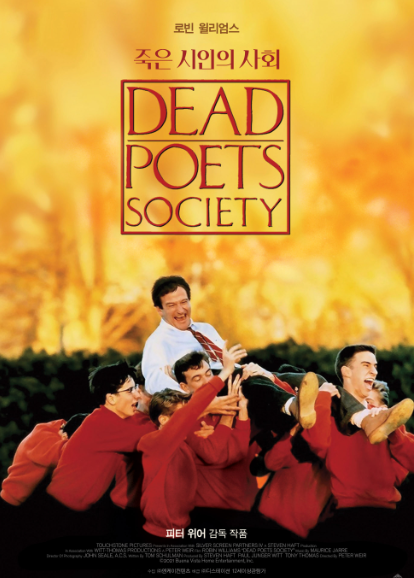The movie “Dead Poets Society,” produced in 1989, tells the story of a teacher who genuinely cares for his students and the students who follow him. Perhaps Todd Buchholz’s book “New Ideas from Dead Economists,” first published in 1990, was inspired by the movie’s title. Robin Williams stars as the English teacher Keating, an alumnus of the prestigious Welton Academy. Unlike the school’s policy, which solely focuses on getting students into top universities, Keating inspires his students to think freely and deeply about life. Seven students, who called him Captain and followed him, formed a circle called “The Dead Poets Society,” as suggested by Keating, which inspired the movie’s title. One day, Keating stands on a desk and asks the students:
“I stand upon my desk to remind myself that we must constantly look at things in a different way.”
To understand the complex world, we often need to dissect it and simplify it through reasoning or imagination. A world seen through dissection and analysis starts to become simpler. We strive to grasp the true nature of the complex world by engaging our imagination. However, the knowledge or theories we acquire cannot be declared as the absolute truth. Take inductive reasoning as an example: if you see a black cat in the morning and another black cat in the afternoon, inductive reasoning might conclude that all cats are black. But sooner or later, you will encounter a white cat. Though extreme, this example shows that knowledge derived from analysis and reasoning is not necessarily the truth. Analyzing, focusing on characteristics, and visualizing are all forms of simplification. Simplification inevitably distances us from reality. Just because a theory simplified to explain phenomena seems true, it does not mean we know the absolute truth. As the saying goes, every theory is a hypothesis, and not many truths have been completely proven.
There is always the possibility that what we know is not the reality. This applies even in non-abstract, non-philosophical contexts. Everything visible has at least two sides. If an object has a front, it must also have a back. The ground we stand on looks different from beneath the earth’s crust, and even a seemingly flat coin has two sides. Different perspectives lead to different appearances. Moreover, differences can appear in both substance and properties. The world comprises substances and the properties that accompany them. A desk and a chair are substances, while their color, shape, and texture are properties. Therefore, we say, “This desk is black” or “That desk is round.” Saying a desk is black and round is just one perspective. Fighting over such differences is meaningless. Colors, in fact, are not inherent in objects but are created by our brain processing light information reflected from objects. Light itself is a particle and a type of wavelength. Sunlight, depending on its wavelength, is divided into infrared, visible, and ultraviolet rays. Sound waves, which we hear and speak, are also wavelengths. Thus, what we see and hear are not the only realities.
Given that even visible and audible things are like this, it is needless to say that things we cannot perceive are even more so. Consider how many meanings the word “love” can have. We all enjoy the numerous perspectives on love. Conversely, not acknowledging these differences in perspective has led to conflicts, enmity, and even wars. Recently, the entire world was divided by the ideological differences between communism and capitalism, treating each other as if they could not coexist on the same planet. Such an era shows how severe differences in perspective can be.
What was once considered truth in one era can be proven wrong in another. Yet, there are countless examples of people clinging to their viewpoints as the absolute truth, refusing to listen to others. Such errors are not exclusive to ordinary people; even great minds have made such mistakes. Aristotle, for example, claimed that heavier objects fall faster. This was debunked by Galileo, the father of modern science, who demonstrated through experiments that objects of different weights fall at the same speed.
In 1829, Martin Van Buren, the governor of New York, sent a letter to President Andrew Jackson opposing railroad construction. He feared that railroads would reduce canal and ship traffic, leading to job losses and economic decline. While this view seems absurd today, it highlights the difficulty of predicting the future. Interestingly, Van Buren emphasized safety concerns in his letter, stating:
“For the above mentioned reasons the government should create an Interstate Commerce Commission to protect the American people from the evils of “railroads” and to preserve the canals for posterity. As you may know, Mr. President, “railroad” carriages are pulled at the enormous speed of 15 miles per hour by “engines,” which in addition to endangering life and limb of passengers, roar and snort their way through the countryside, setting fire to crops, scaring the livestock, and frightening women and children. The Almighty certainly never intended that people should travel at such breakneck speed.”
In “The 7 Habits of Highly Effective Teens,” Stephen Covey’s son Sean Covey cites similar outdated views that now seem foolish. For example, an 1876 Western Union internal memo stated, “The telephone has too many shortcomings to be seriously considered as a means of communication. This device is inherently of no value.” Western Union, known for its telegraph service, failed to see the telephone’s potential, a short-sightedness that contributed to its 1992 bankruptcy as a telecom company.
In 1977, Kenneth Olsen, CEO of Digital Equipment Corporation, dismissed the idea of personal computers, saying, “There is no reason anyone would want a computer in their home.” This short-sightedness ignored the industry’s evolving trends. Similarly, IBM’s founder, Thomas Watson, allegedly stated in 1943, “I think there is a world market for maybe five computers.” Even Bill Gates once said in 1981 that “640KB ought to be enough for anyone.” In 1899, the head of the U.S. Patent Office, Charles H. Duell, reportedly suggested closing the office because “everything that can be invented has been invented.” Though these statements seem absurd now, they were authoritative at the time. Such views are often disproven by new perspectives, leading to the evolution of truth.
Karl Popper, an Austrian philosopher of science, said, “I may be wrong and you may be right, and by an effort, we may get nearer to the truth.” This attitude highlights the importance of humility and openness to other viewpoints. Despite this, many fields still suffer from the arrogance of believing one’s method is the only correct one.
Economics and management, though relatively recent disciplines, have provided insights into understanding society. However, many scholars have been guilty of creating and adhering to their rules. Economics, for instance, has spent time playing mathematical games to prove expertise within its own rules. Today, economics is increasingly incorporating perspectives from other disciplines, including psychology and natural sciences.
Embracing diverse perspectives benefits us by revealing that our knowledge is not absolute. Accepting and understanding other viewpoints enriches our understanding and fosters growth. In academia, this trend is evident. Physicists study capital markets, and psychologists analyze stock markets. Such interdisciplinary approaches can lead to significant advancements. Similarly, our daily lives can be enriched by embracing diverse perspectives. In education, reading books by various authors provides a more comprehensive understanding than relying on a single source.
We might need economists writing about physics, novelists exploring economics, or filmmakers and sports commentators collaborating with academics. Different experiences lead to different interpretations of the same information. The way we process information and our existing knowledge influence our perspectives.
In January 2007, CBS aired a TV movie titled “The Valley of Light,” based on the novel by Terry Kay. The movie begins with a young man named Noah (played by Chris Klein), who participated in World War II and now wanders along American rivers, fishing not for pleasure but to cope with the aftermath of the war. He arrives in a quiet village by a lake and is drawn in by the warm-hearted residents, deciding to stay for a while. He befriends a mute child who recently lost his mother, but the child tragically dies in an accident. To escape the pain, Noah decides to leave the village. However, Eleanor, a widow who also suffers from the war’s impact, tells him:
“You might find a valley where no one has suffered, but I wager to say you won’t find love there either.”
This dialogue underscores the movie’s theme of pain and love being intertwined aspects of human experience.
Nature’s order seems to have at least a duality. A sunny spot in winter can become unbearably hot in summer. A tree that provides shade in summer drops leaves in autumn, creating a mess to clean. Where there is profit, there is risk. If you get a free lunch, you will eventually have to pay for it. This is why economists assert, “There is no such thing as a free lunch.” In the movie “Hwangsanbeol,” General Gyebaek expresses his resolute will by killing his family before the Battle of Hwangsanbeol. He tells his wife, “A tiger leaves its skin when it dies, and a man leaves his name.” She angrily responds, “Tigers die because of their skin, and people die because of their names.” Even a single fact can be interpreted in multiple ways.
Eastern philosophy has long explained the principles of nature and the universe through yin and yang. The hypothesis of yin and yang posits that the order of the universe is achieved through the harmony of opposites. Thus, everything in nature is a combination of yin and yang, which generates and changes all things. Based on this assumption, human bodies, temperaments, fruits, animals, and even abstract concepts are classified as yin or yang. While the extent of this natural philosophy’s truth is unknown, it’s hard to deny the relative nature of all things. Examples include heaven and earth, sun and moon, sea and land, day and night, man and woman, above and below, inside and outside, light and darkness. Nature’s complexity lies in its constant change, governed by cause and effect, action and reaction. Every phenomenon has a cause and result, influenced by a force and its opposite. Today’s result becomes the cause of future outcomes. This principle applies to human life, where no aspect has only one side. Therefore, adopting a dual perspective and recognizing other viewpoints is essential. Acknowledging other perspectives shows consideration, while admitting that one’s
knowledge may not be the absolute truth demonstrates humility. Recognizing duality or diversity aligns with nature’s principles, leading to wisdom in life. Today’s fortune could lead to tomorrow’s challenges, and current suffering might be good training for the future, fostering gratitude for everyday life. Lee Cheol-hwan, author of “The Coal Road,” writes in his essay collection “Apology”:
“Through long hours of pain, I learned that pain can also be a path. There are things you can only see through pain.”


답글 남기기